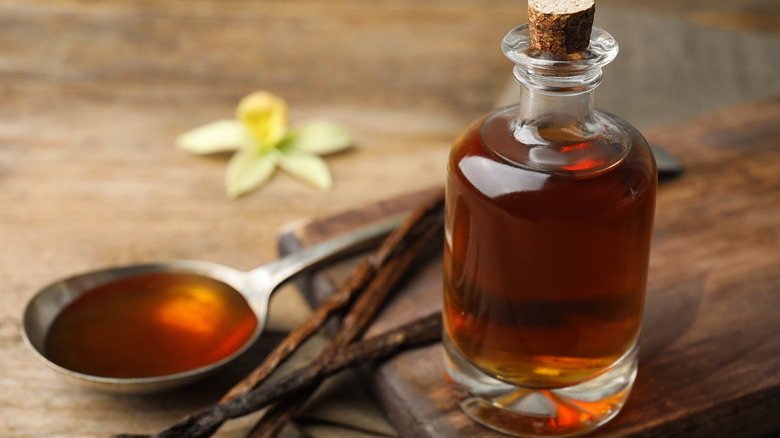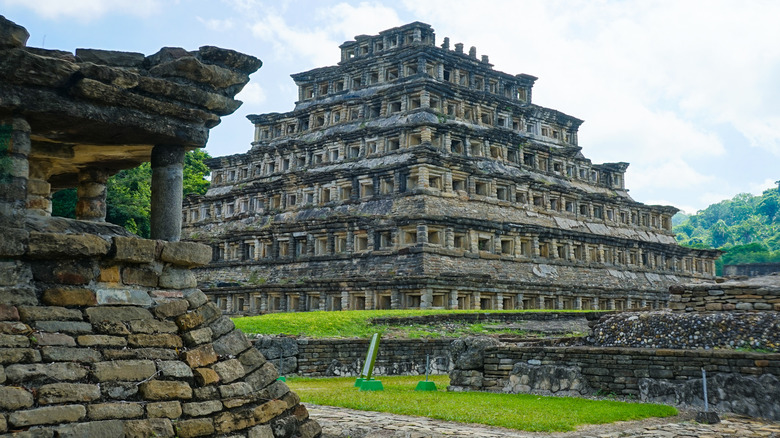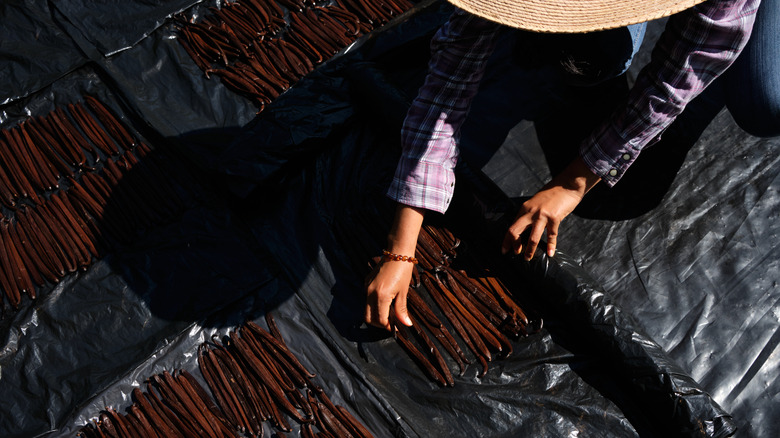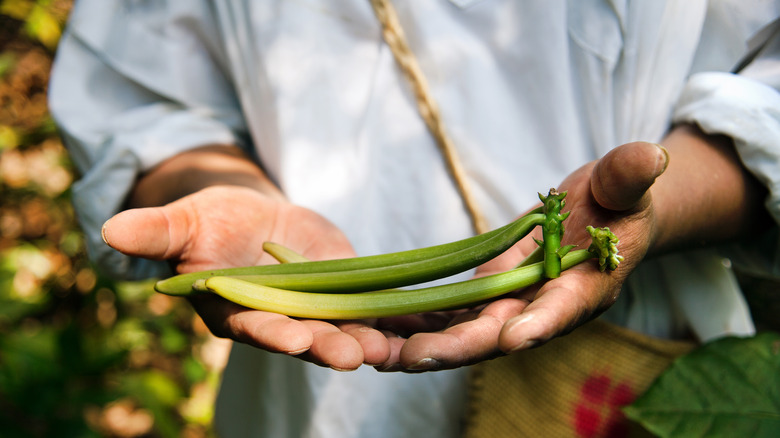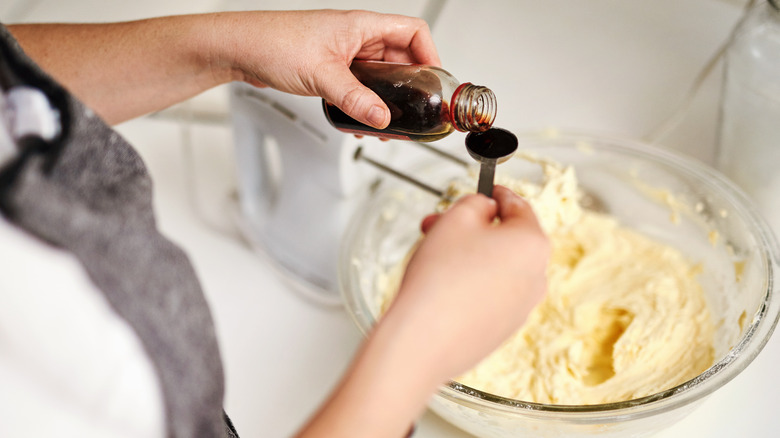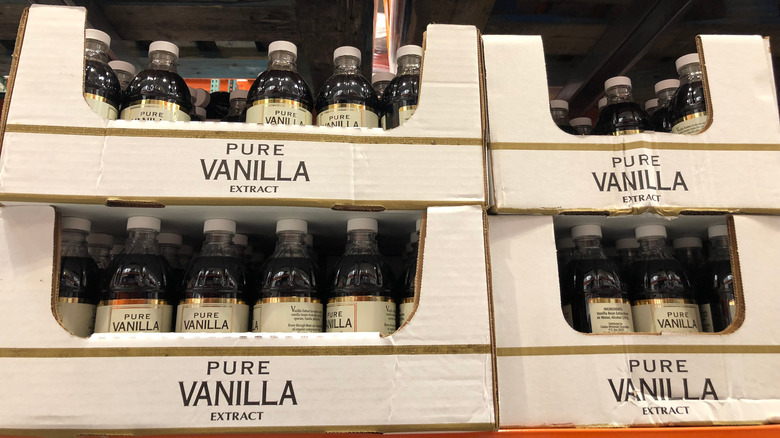How Mexican Vanilla Extract Differs From Other Varieties
Vanilla is one of the most esteemed spices in the world — and vanilla extract, the spice in its liquid form, is no different. But the truth is that the spice only made its way to Europe after the Spanish conquest of the Aztecs, who dominated Northern Mexico up until the early 16th century. They were the first to use vanilla, often alongside cocoa, to flavor their food and drinks. However, the vanilla extract that comes from Mexico is slightly different than the vanilla extract you find at the store.
In fact, vanilla is a lot like wine in the sense that where and how it's grown can drastically impact how it tastes. And if you want a taste of ancient Mesoamerica, the birthplace and source of the world's finest vanilla beans, look no further than Mexican vanilla extract. It is sweet and woodsy, with a deep creamy and spicy-sweet flavor that is similar to clove or nutmeg that can be added to your cocktails or brownies.
History of Mexican vanilla extract
Prior to the Aztecs, another group of aboriginal people known as the Totonacs inhabited northern Mexico. While they may not have been the first to use vanilla in their cuisine, they were the first people to cultivate it. The Totonacs treated vanilla as a sacred herb and used it primarily for rituals and medicine.
Then, when the Aztecs conquered Veracruz in the early 1400s, they began using their newly acquired vanilla supply to flavor their food and drinks. One drink, in particular, was named "Xocohotl" (pronounced "chocohotl"). It was given to the Spanish explorer Hernan Cortez at a ceremony, who took the beans back with him to Europe.
Vanilla quickly became a favorite among European aristocrats and, for the course of the next 300 years, was sent to other tropical regions in the world in an effort to increase production and make the spice more accessible. However, these efforts all went to no avail. That's because the Melopina bees that pollinate vanilla orchids and initiate the growth of the vanilla bean pods only exist in Mexico.
While methods for artificial pollination were eventually discovered (notably by an enslaved 12-year-old boy named Edmond Albius) Mexican vanilla remains the only variety pollinated as nature intended. To this day, the most authentic vanilla grows in Veracruz, Mexico.
How Mexican vanilla extract is made
While the bees may be doing the dirty work, the process of making Mexican vanilla extract is still a very hands-on process. There's none of the meticulous hand pollinating that has to be done for vanilla varieties grown in other regions. But, even after that, there are some differences in the cultivation, harvest, and curing processes of Mexican vanilla extract that make it different than the rest.
After the orchids have been pollinated by the Melopina bees, harvest doesn't begin until the tips of the fruits or beans have turned yellow. This typically happens after the flower dies, around the 9-month mark. That's when the beans can be harvested and dried in preparation for the next process stage: fermenting and curing. In Mexico, this process can take anywhere from three to six months, but it's what seals the vanilla's complex flavor and aroma.
Mexican vanilla is cured by wrapping the beans in blankets and straw mats and putting them inside of ovens for as long as two days. They're then spread in the sun each day before being covered with palm rugs and put inside wooden boxes to ripen. Finally, the beans are vacuum sealed and aged for two to three months. Ultimately, the entire process brings a complex flavor to the vanilla — woodsy, smoked, and pungent notes trained palates can taste.
Mexican vanilla extract vs. other varieties
Mexican vanilla extract differs from your standard vanilla extract in more ways than one — and while the bees can be accredited to some of its fragrance and flavor, they can't take credit for it all. Vanilla grows in regions all along the equator, from the tropical parts of Latin America to Southeast Asia and West Africa.
In turn, there are many different types of vanilla: including Bourbon, Tahiti, and West Indian, just to name a few. When you do a taste test of Mexican vanilla extract versus another vanilla extract, the differences may not be apparent immediately. Discerning the subtle differences requires a certain level of expertise, and luckily Michel Mustiere, the Culinary Director of Velas Resorts, shared all of their notes.
As they told Greatist, Mustiere picks up on astringent, smoked, and toasted notes, among others, along with the flavors of clove, raisin, cinnamon, cocoa, sesame, tamarind, and black pepper. To round it out, all of that is elevated by a subtle spiciness of tuberose, along with a taste of dry chili. Mustiere also notes that Mexican vanilla extract tends to have a thinner consistency than varieties like the Tahitian, delivering its flavor with a bit more delicacy.
Cooking with Mexican vanilla extract
Due to its unique flavor profile, Mexican vanilla extract has some uses that go beyond your basic vanilla flavoring. With it's notes of clove, cinnamon, and nutmeg, Mexican vanilla extract works especially well with chocolate – as the Aztecs did in their ceremonial "Xocohatl" beverage — as well as with citrus fruits like orange, lemon, lime, grapefruit, or even kumquats. Its spiciness brings even more to the table and basically begs to be paired with chile peppers and tomatoes to balance out their heat and acidity. But it can also be substituted in any recipe that typically calls for vanilla.
From French toast to smoothies and from homemade ice cream to whip cream, cookies, cakes, and oatmeal, Mexican vanilla extract can do everything your typical vanilla extract does and more. Substituted at a 1:1 ratio, the subtle differences may not be as apparent, but they do set the stage for inspiration. Take advantage of its unique flavor notes and add a touch of tamarind or dried chilis to anything chocolate based, or add a dash of it to your next fruity cocktail or mocktail for an extra layer of warmth and aromatics.
Where to buy Mexican vanilla extract
When shopping for Mexican vanilla extract, you might think that to get the best of the best, you should go right to the source. But the FDA has warned consumers to be cautious when purchasing vanilla extract in Mexico because it could contain a substance called coumarin, which was banned in the United States in 1954 (via ABC News).
Mexico still hasn't outlawed the chemical, and it is sometimes used in artificial vanilla flavorings. Because food labeling standards tend to be much more lenient in Mexico than in the States, you could end up purchasing a Mexican vanilla extract labeled as "pure," that is, in actuality, artificial.
Besides the potential health effects — including blood thinning, which the FDA claims is particularly dangerous for those who already take blood thinners — purchasing artificial Mexican vanilla when you think you're getting the real thing can feel like a real waste of money. But this isn't to say you should avoid purchasing vanilla from Mexico; you just need to know what to look for.
If the product has a vague ingredient list, says "tonka bean," or has no list, odds are it's not authentic Mexican vanilla. Instead, look for "vanilla bean" on the ingredient list and opt for brands like Blue Cattle Truck that are transparent about their business practices and standards.
